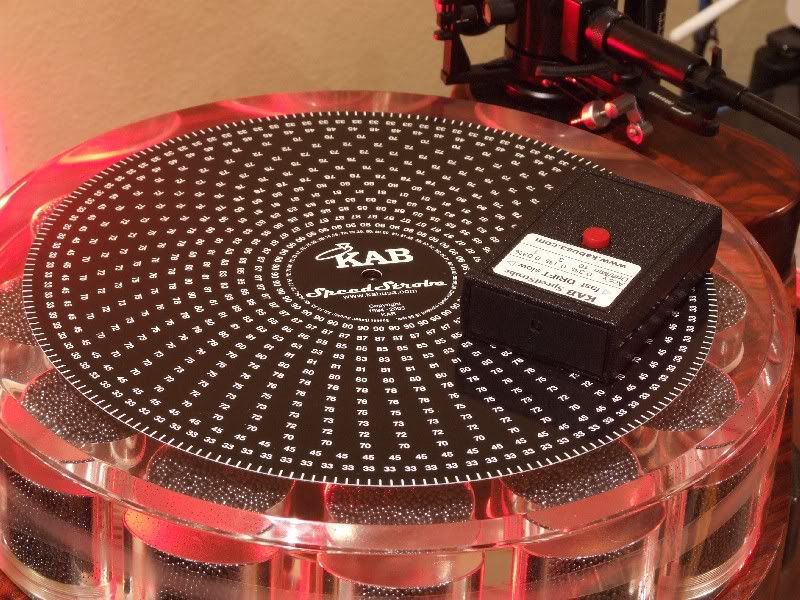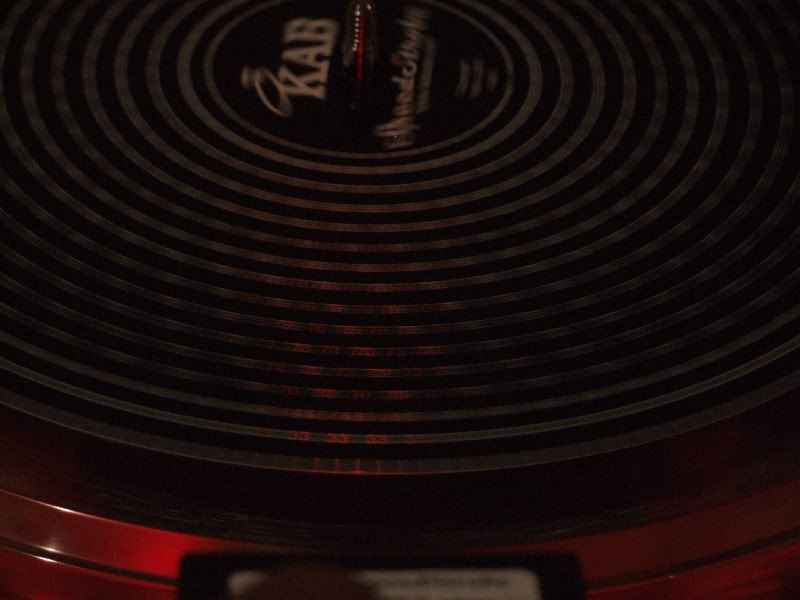KAB Electro Acoustics SpeedStrobe Turntable Speed Measuring Device

DarqueKnight
Posts: 6,765
After many, many years of checking my turntable speed with a standard bar pattern strobe disc and florescent lamp, I broke down and bought a KAB SpeedStrobe. The SpeedStrobe has been on the market since 1995. Using the SpeedStrobe is orders of magnitude more convenient than dragging out my small florescent lamp every time I want to check turntable speed.
Now, all I do is put the SpeedStrobe's 10" plastic mat on the platter and shine the strobe's quartz locked 60 Hz LED on the mat. Rather than the radial hypnotic bar patterns we've grown accustomed to, the KAB disc uses radial patterns of number icons corresponding to the speed being measured (eg. 33, 45, 78, etc.)

Figure 1. KAB SpeedStrobe - I should have acquired one a long time ago.

Figure 2. Speed locked in at a perfect 33.33 rpm.
The only peeve I have about the SpeedStrobe is the instruction sheet left out some details about calculating speed error. I emailed KAB's owner, Kevin Barrett, for the missing information.
The instruction sheet states:
"If your turntable has adjustable speed, set the adjustment so that the speed number, 33 for instance, is frozen still. This is 99.99% accurate.
If your turntable is a fixed speed model, just count the numbers moving in and out of the spotlight over one minute. This will give you the degree of error in your turntable speed.
DRIFT/MIN 10 = 0.3% ACCURACY
DRIFT/MIN 3 = 0.1% ACCURACY
DRIFT/MIN 1 = 0.03% ACCURACY"
A label on the LED strobe light indicated that icons drifting to the left indicated fast speed and icons drifting to the right indicated slow speed.
I wanted to know if the three icon drift examples given above just applied to 33-1/3 rpm or to all speeds. Furthermore, I wanted to know how to calculate speed accuracy if the icon drift was some other number than 1, 3, or 10.
Kevin Barrett's reply:
'The product of rpm and strobe icon frequency is always 3600.
For 45 rpm there are 80 icons on the disk, 45 x 80 = 3600.
For 33.33 rpm there are 108 icons on the disk, 33.33 x 108 = 3600.
A 10 icon drift at any speed would be:
10/3600 = 0.00277 x 100 = 0.27%, which I rounded up to 0.3% [in the instruction sheet example].
The KAB website provided the formula for calculating the number of icons required for measuring a specific platter speed:
N = F/RPM x 60, where
N = number of icons spaced around the disc.
F = strobe light frequency in Hertz.
RPM = platter speed in revolutions per minute.
For 33.33 rpm and a strobe light frequency of 60 Hz this calculation would be
N = 60/33.33 x 60 = 108.
For 45 rpm and a strobe light frequency of 60 Hz this calculation would be
N = 60/45 x 60 = 80.
Using a lamp that is locked on to the AC power line frequency has the potential for measurement error because the power line frequency is not always at or very close to the nominal 60 Hz. For example, if the line frequency was actually 58 Hz, the number of strobe pattern icons required at 33.33 rpm would be:
N = 58/33.33 x 60 = 104.
In this case, using a strobe disc with 108 icons would introduce some significant measurement error. Fortunately, for most of us on the North American power grid, power line frequency stays close to the nominal 60 Hz.
Now, all I do is put the SpeedStrobe's 10" plastic mat on the platter and shine the strobe's quartz locked 60 Hz LED on the mat. Rather than the radial hypnotic bar patterns we've grown accustomed to, the KAB disc uses radial patterns of number icons corresponding to the speed being measured (eg. 33, 45, 78, etc.)

Figure 1. KAB SpeedStrobe - I should have acquired one a long time ago.

Figure 2. Speed locked in at a perfect 33.33 rpm.
The only peeve I have about the SpeedStrobe is the instruction sheet left out some details about calculating speed error. I emailed KAB's owner, Kevin Barrett, for the missing information.
The instruction sheet states:
"If your turntable has adjustable speed, set the adjustment so that the speed number, 33 for instance, is frozen still. This is 99.99% accurate.
If your turntable is a fixed speed model, just count the numbers moving in and out of the spotlight over one minute. This will give you the degree of error in your turntable speed.
DRIFT/MIN 10 = 0.3% ACCURACY
DRIFT/MIN 3 = 0.1% ACCURACY
DRIFT/MIN 1 = 0.03% ACCURACY"
A label on the LED strobe light indicated that icons drifting to the left indicated fast speed and icons drifting to the right indicated slow speed.
I wanted to know if the three icon drift examples given above just applied to 33-1/3 rpm or to all speeds. Furthermore, I wanted to know how to calculate speed accuracy if the icon drift was some other number than 1, 3, or 10.
Kevin Barrett's reply:
'The product of rpm and strobe icon frequency is always 3600.
For 45 rpm there are 80 icons on the disk, 45 x 80 = 3600.
For 33.33 rpm there are 108 icons on the disk, 33.33 x 108 = 3600.
A 10 icon drift at any speed would be:
10/3600 = 0.00277 x 100 = 0.27%, which I rounded up to 0.3% [in the instruction sheet example].
The KAB website provided the formula for calculating the number of icons required for measuring a specific platter speed:
N = F/RPM x 60, where
N = number of icons spaced around the disc.
F = strobe light frequency in Hertz.
RPM = platter speed in revolutions per minute.
For 33.33 rpm and a strobe light frequency of 60 Hz this calculation would be
N = 60/33.33 x 60 = 108.
For 45 rpm and a strobe light frequency of 60 Hz this calculation would be
N = 60/45 x 60 = 80.
Using a lamp that is locked on to the AC power line frequency has the potential for measurement error because the power line frequency is not always at or very close to the nominal 60 Hz. For example, if the line frequency was actually 58 Hz, the number of strobe pattern icons required at 33.33 rpm would be:
N = 58/33.33 x 60 = 104.
In this case, using a strobe disc with 108 icons would introduce some significant measurement error. Fortunately, for most of us on the North American power grid, power line frequency stays close to the nominal 60 Hz.
Proud and loyal citizen of the Digital Domain and Solid State Country!
Post edited by DarqueKnight on
Comments
-
I sure value mine. The one thing I would add is if you do not have a table with controlled/quartz locked speed such as your Teres and some direct drive tables, the speed should be checked/adjusted with the needle in the groove. You can catch enough at the beginning of an LP or use a smaller diameter 45 with spindle adapter.

Picture credit to Blake (blakeh) from the 04/19 RAS meet at Rob's (scot62) place.Salk SoundScape 8's * Audio Research Reference 3 * Bottlehead Eros Phono * Park's Audio Budgie SUT * Krell KSA-250 * Harmonic Technology Pro 9+ * Signature Series Sonore Music Server w/Deux PS * Roon * Gustard R26 DAC / Singxer SU-6 DDC * Heavy Plinth Lenco L75 Idler Drive * AA MG-1 Linear Air Bearing Arm * AT33PTG/II & Denon 103R * Richard Gray 600S * NHT B-12d subs * GIK Acoustic Treatments * Sennheiser HD650 * -
The SpeedStrobe instruction sheet has a section on "Compensating For Static Stylus Drag" which advises measuring the speed with a 7" 45 rpm disc on the SpeedStrobe disc. At the end of this section there is a note that says "this only applies to non servo controlled drive systems".
The Reference II motor that drives my Teres turntable has a servo circuit that makes corrections for the variable stylus drag that occurs as the cartridge moves across the record.
I timed the servo circuit at 33.33 rpm to see how long it took to get back to correct speed after the needle was placed in the groove. After the needle was lowered on the record, three icons would drift to the right in one minute. This represented a speed error of:
3/3600 = 0.0008 x 100 = 0.08% slow.
However, the icons would stop drifting after 40 to 45 seconds when the servo circuit locked back on the correct speed.:)Proud and loyal citizen of the Digital Domain and Solid State Country!
